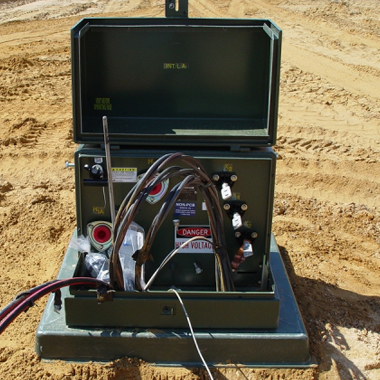

Electrical Engineering | Clearances for Pad-Mounted Transformers
Posted in Engineering
Many buildings are located in developments, or on sites with underground electrical and tele/data/cable utilities. While the underground services eliminate unattractive overhead pole lines, cabling and transformers, the installation of utility company transformers presents challenges of a different sort.
Utility company transformers are large, generally green in color, and can range from a small box (3’w x 3’d x 2’h) in a residential neighborhood, to a large enclosure with oil-filled cooling fins (7’w x 7’d x 6’h) on a large pre-concrete base. Often for aesthetic reasons the transformers are located remote from the building, but due to costs associated with the secondary conductors, a transformer may be mounted close to a building.
This article will define some of the requirements for clearances around a transformer, as well requirements for protecting a transformer from vehicular traffic.
Adjacent to buildings, transformers must generally be located in accordance with the following requirements. First, a transformer must be installed with the front (doors) facing away from the building, with no balconies or overhangs above. The transformer must be accessible to line trucks (size and weight similar to a cement truck), for maintenance or replacement. Generally, a transformer located near a building requires 4ft clearance from the building vertical surfaces, assuming no windows from grade to 18ft. The sides of the transformer must be clear of all objects (including landscaping) for 3ft, and the transformer should be located 10ft horizontally from doors, windows or fire hydrants. The front (door side) of the transformer shall have a clearance of 10ft so that line crews can safely perform maintenance or repairs on the equipment. This required clearance includes landscaping. When encountering landscaping during emergency repairs, the utility can remove the landscaping (not very gently) or leave and await notification the offending vegetation has been removed. During routine maintenance, the utility will not attempt to work on the transformer until the landscaping has been removed.
Transformers in locations subject to vehicle traffic must be protected, and oftentimes these protections must be in place before the transformer is energized, even during construction. The vehicle barrier system is relatively simple. A series of bollards located around the transformer, spaced no greater than 54” on center, and located 36” away from transformer are required. Often, the utility company will require these to be painted traffic yellow, where adjacent to parking or roadways. The bollards around the sides and back of the transformer are permanent, made of concrete filled 6” rigid steel conduit, encased in 3”(min) concrete. The permanent bollards shall extend 42” above grade, and extend 54” below grade. In front of the transformer doors the bollards are required to be removable. The removable bollards are constructed of 6”PVC sleeve , 54” long, and encased in 3” of concrete. A 96” long section of 5” rigid galvanized steel conduit, with cap, is then slid into the PVC sleeve.
Utility company transformers located on a site must also be located a minimum of 48” from fire hydrants.
Following these simple guidelines will be a good start in meeting utility company requirements. Of course, verifying the local utility requirements prior to construction will help eliminate additional charges, or delays in the installation of the transformer.

 Previous STORY
Previous STORY